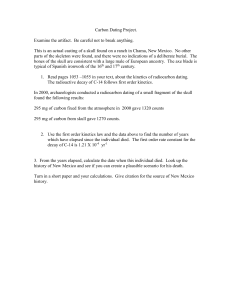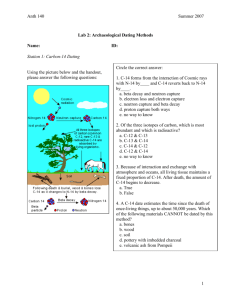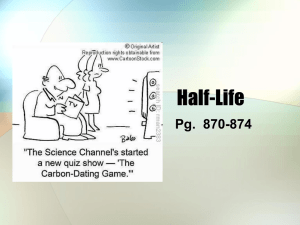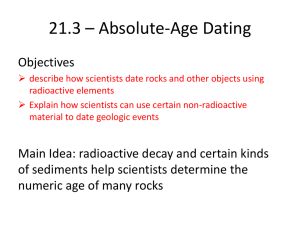C-14 Dating
advertisement
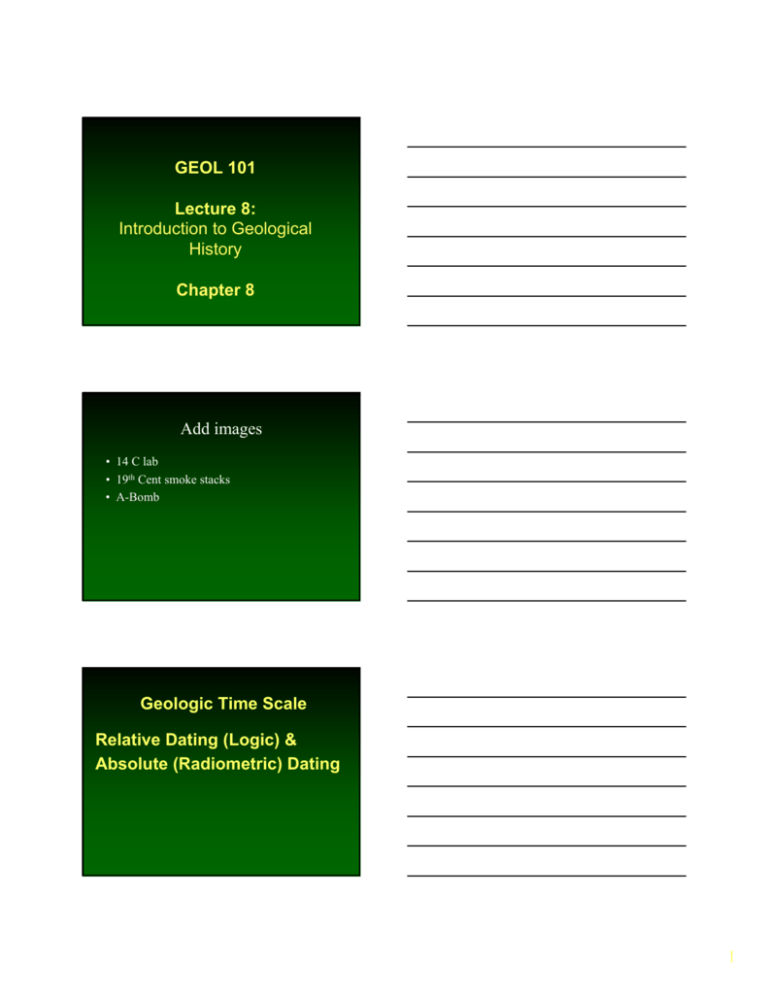
GEOL 101 Lecture 8: Introduction to Geological History Chapter 8 Add images • 14 C lab • 19th Cent smoke stacks • A-Bomb Geologic Time Scale Relative Dating (Logic) & Absolute (Radiometric) Dating 1 General Rules for Interpreting Sedimentary Rocks • • • • • Law of Original Horizontality Law of Superposition Law of Cross-Cutting Relationships The Meaning of Unconformities Concept of Facies = (Environments of Formation) • Correlation Tools Original Horizontality • Horizontal Beds vs. Vertical Beds Up Up What’s It All Mean? Horizontal Bedding: U.S. Rt. 19, Powell Mtn., WV J.S. Kite Photo 2 GEOL 101 Lecture # General Rules for Interpreting Sedimentary Rocks • • • • • Law of Original Horizontality Law of Superposition Law of Cross-Cutting Relationships The Meaning of Unconformities Concept of Facies = (Environments of Formation) 3 Superposition • Stratified Sediments or Rocks • Younger “Rocks” - Added to Top of a Sequence • Oldest “Rocks” at the Bottom of Sequence Horizontal Bedding: U.S. Rt. 19, Powell Mtn., WV J.S. Kite Photo Superposition • Oldest “Rocks” are at the Bottom. • Younger Rocks are at the top. Youngest Oldest 4 Breached (Eroded) Folds & Age of Rocks. Superposition: Youngest on Top Younger Rocks Older Rocks Where are older rocks exposed at the surface? Younger Rocks • • • • • General Rules for Interpreting Sedimentary Rocks Law of Original Horizontality Law of Superposition Law of Cross-Cutting Relationships The Meaning of Unconformities Concept of Facies = (Environments of Formation) Cross-Cutting Relationships • Younger Intrusions or Faults Cut Across Older Rocks . 5 Fault Parts Cross-Cutting Relationships - Plutons Explain the geological history represented by an outcrop of basalt that is intruded by a dike of rhyolite porphyry. The 5-10 cm of rock that was basalt along the dike is now hornfels. Which rock was there first? Which was there second? What caused the hornfels? 6 • • • • • General Rules for Interpreting Sedimentary Rocks Law of Original Horizontality Law of Superposition Law of Cross-Cutting Relationships The Meaning of Unconformities Concept of Facies = (Environments of Formation) Unconformity • Buried Erosion Surface . Unconformity, Ouray Colorado 7 Unconformity, Ouray Colorado Late Devonian sandstone Elbert Formation ~360 million years old Unco nform ity: ~ 1,000 , 000,0 0 0 yea rs m issin g Precambrian shale, siltstone & sandstone (Uncompahgre formation ~1.5 billion years old) Vince Matthews, Colorado G.S. source for text information. General Rules for Interpreting Sedimentary Rocks • • • • • Law of Original Horizontality Law of Superposition Law of Cross-Cutting Relationships The Meaning of Unconformities Concept of Facies = (Environments of Formation) 8 Maturity Immature Sediments Mature Sediments Facies Tools to Reconstruct Relative Ages in Earth History • Correlation . Correlation: • Marker Beds –Volcanic Ash –Iridium Layer •(Bolide Impact) . 9 Volcanic Ash Marker Beds Iridium Layer 0 ,0 65 00 0, 0 ye s ar d ol Great Relative Dating Tool: Fossils Trilobite 10 Correlation with Fossils Strata = Layers Stratigraphy = Study of Layered Rocks Stratigraphic Units • Groups • Formations • Members 11 Formation • Smallest Mappable Stratigraphic Unit • (vs. Outcrop) Morgantown Stratigraphy • • • • Monongahela Group Conemaugh Group Allegheny Group Pottsville Group Bits of Local Stratigraphy • Monongahela Group • Waynesburg Formation • Uniontown Formation • Pittsburgh Formation • Pittsburgh Coal - $$$ • Conemaugh Group • Clarksburg Shale • Morgantown Sandstone 12 Local Stratigraphy • Pottsville Group • Connequenessing Formation • Upper Connequenessing Sandstone Crops Out at Coopers Rock Absolute Dating • E.G. Radiometric Dating • * Table 8.3, p. 195 * • Plummer et al. 10th ed • Expect Questions Meadowcroft Rock Shelter, Avella, PA: Occupied 17,000 years ago How Do we Know That? 13 How Do we Know That? Carbon-14 Dating = Radiocarbon Dating Carbon Isotopes Common, Stable Uncommon, Stable Uncommon, Radioactive Cosmic Rays “Zap” a Nitrogen-14 Proton into a Neutron to Form C-14 Beta Capture 14 C-14 Dating • C-14 mixed thru Atmosphere • Plants take in C-14 • Animals Eat Plants • Other Animals Eat Animals ... etc. • All living things include C-14 C-14 Dating • Dead Things Do Not Take in New C-14 (or C-12 or C-13) • C-14 Decays w/ Time • C-12, C-13 Does Not. Carbon - 14 is Radioactive • Decays back into N-14 at Known Rate • Half-Life is 5730 yr N-14 C-14 15 C-14 Dating • In 5730 years (1 Half-Life), Half of C-14 will Decay • In next 5730 years, Half of what was left will Decay –3/4ths will decay in 11,460 yr • 7/8ths will decay in 17,190 yr • etc.... C-14 Dating • <0.1 % of C-14 is Left After 57,000 yr • Most Labs “poop out” at >40,000 to >50,000 yr C-14 Dates • • • • Years Before Present (yr B.P.) Present = A.D. 1950 +/- Measurement Error example: 22,500 +/- 450 yr B.P. 16 What Can C-14 Dating Be Used For? • Dating Dead Things • <100,000 years Bristlecone Pine Tree-Ring Calibration of C14 Dating http://www.sonic.net/bristlecone/Images2.html Dendrochronology Another Absolute Dating Method 17 Carbon - 14 Basic Assumptions # 1: Predictable Decay Rate # 2: Constant C-14 Production Rate # 3: All Living Things have Same Portions of C-14, C-12, & C-13 Obvious Problems w/ C-14 Dating • No Good for Most Minerals • Useless on Really Old Stuff –Find Another Method Problems w/ C-14 Dating • Basic Assumption # 3 : – All Living Things DO NOT have Same % of C-14, C-12, & C-13 • Bottom Waters • Antarctic Ocean Diluted by Glacial Meltwaters 18 Problems w/ C-14 Dating Basic Assumption # 2 : –C-14 not Constant in Atmosphere –Sun’s Cosmic Ray Output not Constant –More C-14 in Past –10,000 yr BP = 11,500 Calendar yr Man’s Impact • Industrial Revolution - Fossil Fuels diluted C-14 • Atmospheric Nuclear Testing increased C-14 Problems w/ C-14 Dating • Biggest Problem = –Stupid Geologist - • 2nd Biggest Problem = –Contamination of Samples • Young Carbon • Old Carbon 19 Geologic Cross Section - Hawaii Highlights of Earth History and Absolute Geologic Time • ~13.7 BY (BY = billion years): Universe forms • 4.55 - 4.60 BY: Earth forms • (Rest of Solar System, too) – Molten Magma Surface, – Methane, Ammonia, Hydrogen Atmosphere – High UV Radiation – Amino Acids etc. Geologic History Zircon Photo: J. Valley • 4.4 BY – Oldest Mineral (Zircon xl) • 3.8 - 4.1 BY – Oldest Known Rocks, Chemical Fossils • 3.5 BY – Algae - Stromatolites • 1.8 - 2.0 BY – Oxygen "Crisis" • 1.5 - 1.7 BY – Sex Stromatolites, South Africa 20 Geologic Time • 600-650 MY (MY = million years) – First Complex Animals Hallucigenia sparsa Anomalocaris canadensis Big Changes • ~551 MY – First Hard-Shelled "Critters" Trilobites fossils common • ~500 MY – all phylum of higher animals exist, including chordates (vertebrates) 551-245 MY • Paleozoic (=“Old Animals”) Era 21 245 - 65 MY Mesozoic Era Age of Reptiles Allosaurus fragilis, a large Jurassic theropod, one step away from capturing a Dryosaurus altus. www.dinosaursinart.com/allosaurus/ IMAG0009.JPG 65 - 0 MY • Age of Mammals (Cenozoic Era) Horses through Time 22 The Geologic Time Scale • See p. 195 –in Plummer et al, 9th edition • Dates to Know : • 65 MY, 245 MY, 551 MY, 4.5-4.6 BY Question of Time If you plotted all of geologic time on a time line as long as the circumference of the Earth (25,000 mi or 40,000 km), what distance would represent 1 year? Earth Image Source: www.ameritech.net/users/ paulcarlisle/earth.jpg Question of Time • If you plotted all of geologic time on a time line as long as the circumference of the Earth (25,000 mi or 40,000 km), what distance would represent 1 year? • What distance would represent 75 years? • What distance would represent 1 semester (4 months = 0.33 year)? • What distance would represent this lecture? 23 The Whole Earth Time Line • Circumference of the Earth is 25,000 mi (40,000 km) • What distance would represent 1 year? –Figure this out in small groups. –Easiest if we use metric units • Divide Distance by # of Years (4,600,000,000 yr) The Whole Earth Time Line 40,000 km / 4,600,000,000 yr = distance represented by 1 year? 40,000,000 m / 4,600,000,000 yr = 4,000,000,000 cm / 4,600,000,000 yr = 0.87 cm / yr (0.34 inch / year) The Whole Earth Time Line 0.87 cm / yr (0.34 inch / year) X 75 yr = 65 cm (Lifetime = 25.7 inches) X 0.33 yr = 0.29 cm (Semester = ~1/8 inch) 24 Whole Earth Time Line 40,000,000,000,000 microns / (4,600,000,000 yr X 365 day/yr X 24 hr/day) = 0.99 micron / hour This Lecture would be just over 1 micron long on the Whole Earth Time Line. The paper you are writing on is about 100 microns thick 25



